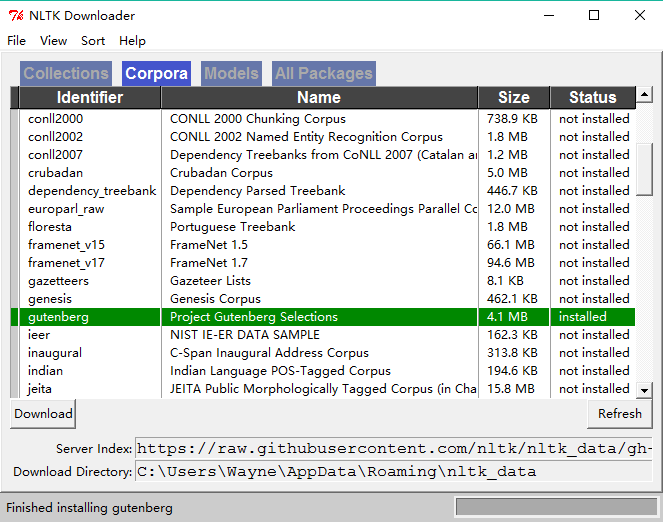6. Python的理工类应用
6.1 简单的三角函数计算
 np.sin(x)
np.sin(x) 
6.2 一组数据的傅立叶变换

# -*- coding: utf-8 -*- """ Created on Tue Jan 24 13:07:01 2017 @author: Wayne """ import scipy as sp import pylab as pl listA = sp.ones(500) # 生成一个含500个元素的序列,元素的值为1 listA[100:300] = -1 f = sp.fft(listA) pl.plot(f) pl.show()

6.3 Biopython:一个使用Python开发计算分子生物学工具的国际社团
功能:将生物信息学文件分析成Python可利用的数据结构;处理常用的在线生物信息学数据库代码;提供常用生物信息程序的界面
安装:打开Anaconda Prompt,输入conda install Biopython(conda list 会列出所有已安装的python包和框架)
7. Python的人文社科类应用
7.1 NLTK语料库

7.2 古腾堡项目
7.2.1 gutenberg包下载
 =>
=> 
7.2.2 计算NLTK中目前收录的gutenberg项目的书

In[30]: from nltk.corpus import gutenberg In[31]: gutenberg.fileids() Out[31]: [u'austen-emma.txt', u'austen-persuasion.txt', u'austen-sense.txt', u'bible-kjv.txt', u'blake-poems.txt', u'bryant-stories.txt', u'burgess-busterbrown.txt', u'carroll-alice.txt', u'chesterton-ball.txt', u'chesterton-brown.txt', u'chesterton-thursday.txt', u'edgeworth-parents.txt', u'melville-moby_dick.txt', u'milton-paradise.txt', u'shakespeare-caesar.txt', u'shakespeare-hamlet.txt', u'shakespeare-macbeth.txt', u'whitman-leaves.txt']
7.2.3 一些简单的计算(单词数量,某单词数量,不重复单词数量,多于n个字母的单词)

In [30]: from nltk.corpus import gutenberg In [31]: gutenberg.fileids() # 显示gutenberg项目中收录的书籍 Out[31]: [u'austen-emma.txt', u'austen-persuasion.txt', u'austen-sense.txt', u'bible-kjv.txt', u'blake-poems.txt', u'bryant-stories.txt', u'burgess-busterbrown.txt', u'carroll-alice.txt', u'chesterton-ball.txt', u'chesterton-brown.txt', u'chesterton-thursday.txt', u'edgeworth-parents.txt', u'melville-moby_dick.txt', u'milton-paradise.txt', u'shakespeare-caesar.txt', u'shakespeare-hamlet.txt', u'shakespeare-macbeth.txt', u'whitman-leaves.txt'] In [32]: allwords = gutenberg.words('shakespeare-hamlet.txt') # 所有的单词 In [33]: len(allwords) # 一共的单词数量 Out[33]: 37360 In [34]: len(set(allwords)) # 不重复的单词数量 Out[34]: 5447 In [35]: allwords.count('Hamlet') # 单词'Hamlet'出现的次数 Out[35]: 99 In [36]: A = set(allwords) # 不重复的单词集合 In [37]: longwords = [w for w in A if len(w)>12] # A集合中,长度大于12的单词 In [38]: sorted(longwords) # 按大小写字母排序 Out[38]: [u'Circumstances', u'Guildensterne', u'Incontinencie', u'Recognizances', u'Vnderstanding', u'determination', u'encompassement', u'entertainment', u'imperfections', u'indifferently', u'instrumentall', u'reconcilement', u'stubbornnesse', u'transformation', u'vnderstanding']
7.2.4 NLTK中自己的一些函数

# -*- coding: utf-8 -*- """ Created on Tue Jan 24 13:07:01 2017 @author: Wayne """ from nltk.corpus import gutenberg from nltk.probability import * allwords = gutenberg.words('shakespeare-hamlet.txt') fd2 = FreqDist([sx.lower() for sx in allwords if sx.isalpha()]) # allwords中的是字母的提取出来并小写,做成频率分布 print fd2.B() # 所有的单词数量 print fd2.N() # 不同的单词数量 fd2.tabulate(20) # 提取前二十个制作成表格 fd2.plot(20) fd2.plot(20, cumulative=True) # cumulative表示累积


7.3 就职演说语料库
7.3.1 下载 inaugural 包
7.3.2 计算 'freedom' 出现的频率

In [61]: from nltk.corpus import inaugural In [62]: fd3 = FreqDist([s for s in inaugural.words()]) In [63]: fd3.freq('freedom') Out[63]: 0.0011939479191683535
7.3.3 将1950年后的机制演说根据单词长度进行频率统计:

# -*- coding: utf-8 -*- """ Created on Tue Jan 24 13:07:01 2017 @author: Wayne """ from nltk.corpus import inaugural from nltk.probability import ConditionalFreqDist from matplotlib import pyplot as plt cfd = ConditionalFreqDist( # 条件频率统计 (fileid, len(w)) # 根据单词长度进行统计 for fileid in inaugural.fileids() for w in inaugural.words(fileid) if fileid>'1950') # 1950年以后 print cfd.items()[:40] cfd.plot()


